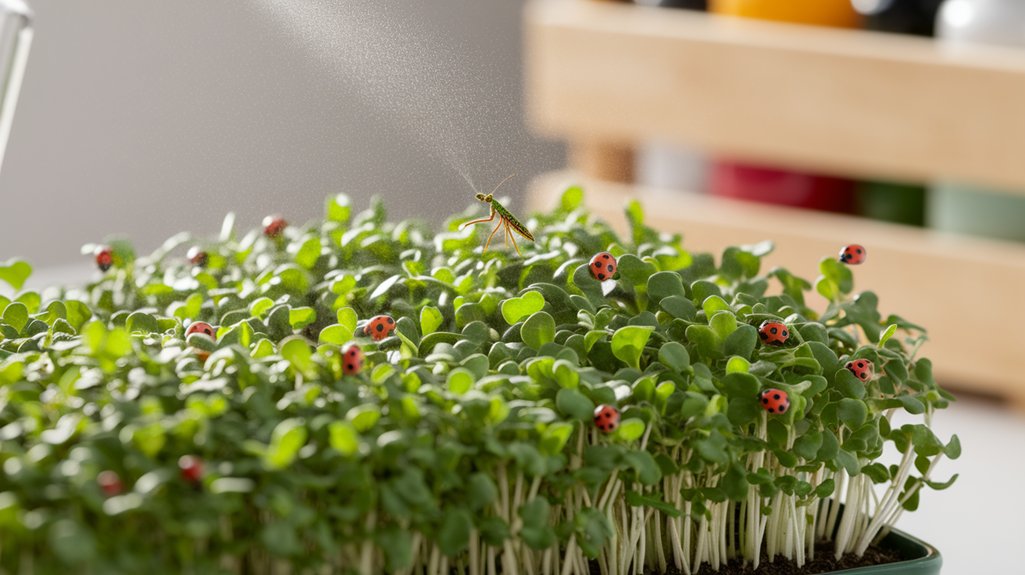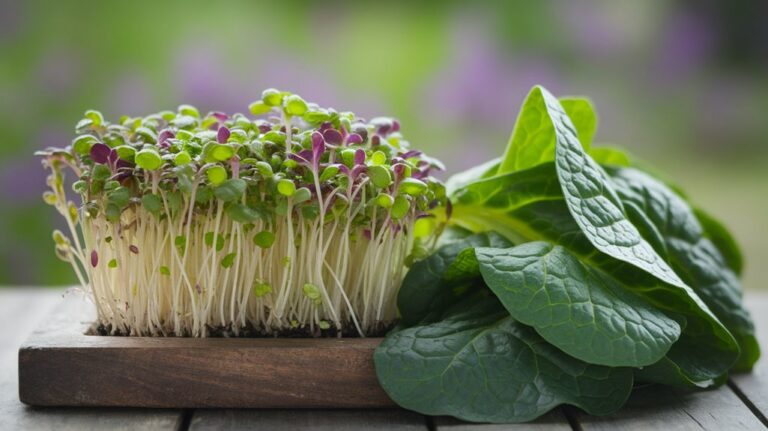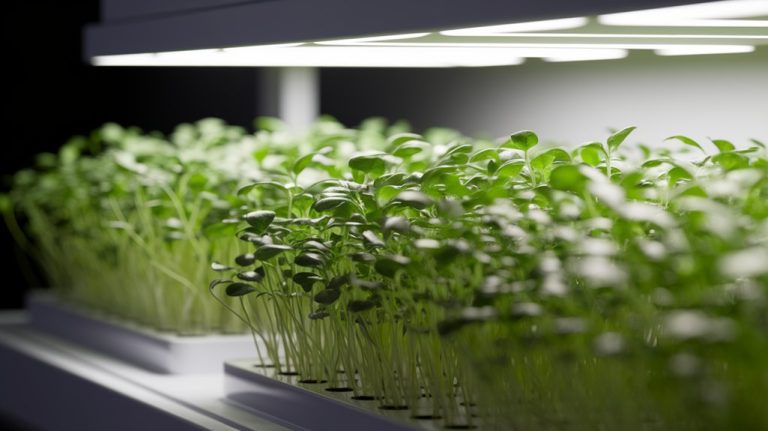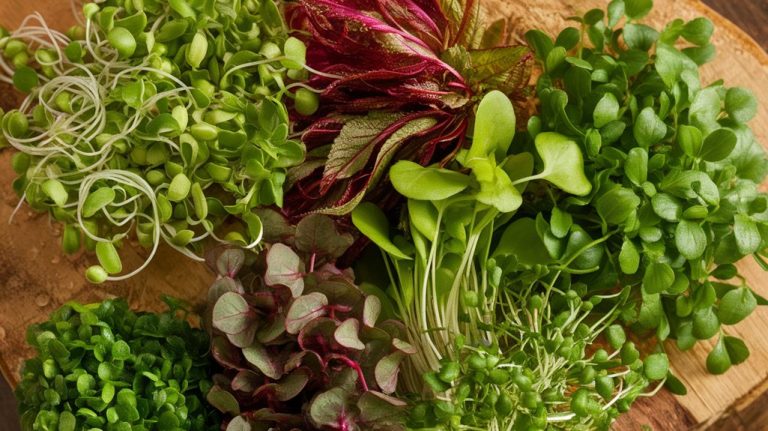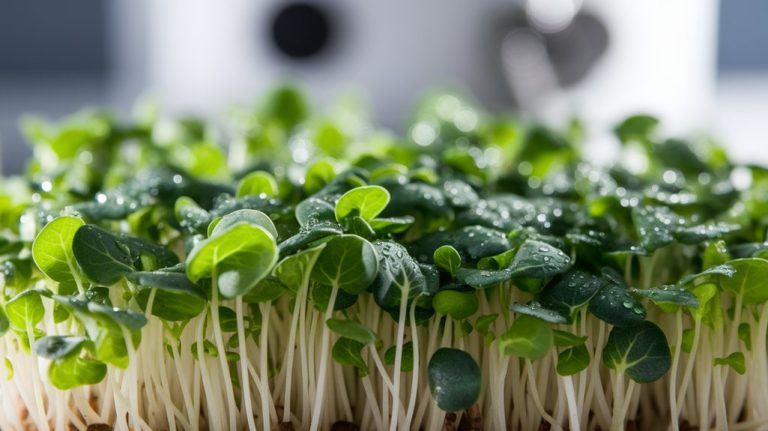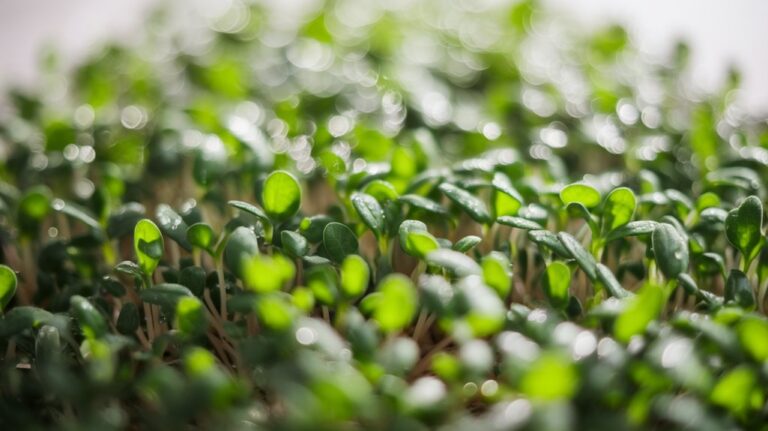Pest Problems? Safe, Natural Ways to Protect Microgreens
I’ve found that protecting microgreens from pests can be safe and natural. Using essential oils like peppermint and rosemary can deter common pests. Homemade sprays, such as garlic or neem oil, disrupt insects’ feeding cycles. Additionally, maintaining ideal growing conditions, like humidity levels and temperatures, helps keep pests at bay. I’ve also learned about the benefits of companion planting and encouraging beneficial insects. There’s so much more to explore on these effective strategies.
Key Takeaways
- Use essential oils like peppermint and rosemary to naturally repel common pests such as aphids and whiteflies without harming your microgreens.
- Create homemade garlic and neem oil sprays to disrupt insect feeding and breeding cycles while promoting plant health.
- Maintain optimal growing conditions with temperatures between 65°F to 75°F and humidity levels of 40-60% to reduce pest susceptibility.
- Encourage beneficial insects by planting flowers and herbs that attract them, creating a balanced ecosystem in your garden.
- Regularly monitor and clean your growing area to remove debris that can harbor pests and promote healthier microgreens.
Understanding Common Pests That Affect Microgreens

While growing microgreens can be a rewarding experience, it’s essential to recognize the common pests that might invade your little garden.
I’ve encountered several pests, and understanding them helps in managing their impact.
Aphids are tiny, green, and can cluster on leaves, sucking the life out of your plants.
Then there are fungus gnats, which thrive in damp soil and can damage roots.
You may also find spider mites, which are almost invisible but leave fine webbing behind.
Lastly, whiteflies can be a nuisance, often hiding on the undersides of leaves.
Identifying these pests early on is crucial for preventing damage and ensuring a healthy microgreen harvest.
Keep an eye out for signs of infestation to act quickly.
Natural Pest Deterrents: Essential Oils and Sprays
When it comes to protecting my microgreens, I’ve found that essential oils can be powerful natural pest deterrents.
I’ll share some effective oils and simple homemade spray recipes that really help keep those pesky insects at bay.
Let’s explore how these natural solutions can enhance the health of our microgreens.
Effective Essential Oils
Have you ever considered using essential oils as a natural way to protect your microgreens? I’ve found that certain essential oils can be effective pest deterrents.
For example, peppermint oil repels aphids and spider mites, while rosemary oil can deter whiteflies. Both oils possess antifungal properties, which helps keep your microgreens healthy.
When using essential oils, it’s crucial to dilute them properly. A few drops mixed with water can create a potent spray. You’ll want to test a small area first to ensure your microgreens tolerate the mixture.
Additionally, applying these oils during the early morning or late afternoon minimizes the risk of leaf burn. Incorporating essential oils into your pest management routine can be a safe, natural alternative.
Homemade Spray Recipes
Many gardeners overlook the power of homemade sprays for protecting microgreens from pests. I’ve found that simple recipes using common household ingredients can effectively deter unwanted critters.
One of my favorites is a garlic spray; just blend a few cloves with water, strain it, and mix in a bit of liquid soap. This concoction not only repels pests but also can boost your plants’ resilience.
Another great option is a neem oil spray. Mix one tablespoon of neem oil with a quart of water and a few drops of dish soap. This natural solution disrupts insects’ feeding and breeding cycles without harming your microgreens.
Always test any spray on a small area first and apply during cooler parts of the day to prevent leaf burn.
Companion Planting: Boosting Your Microgreens’ Defense
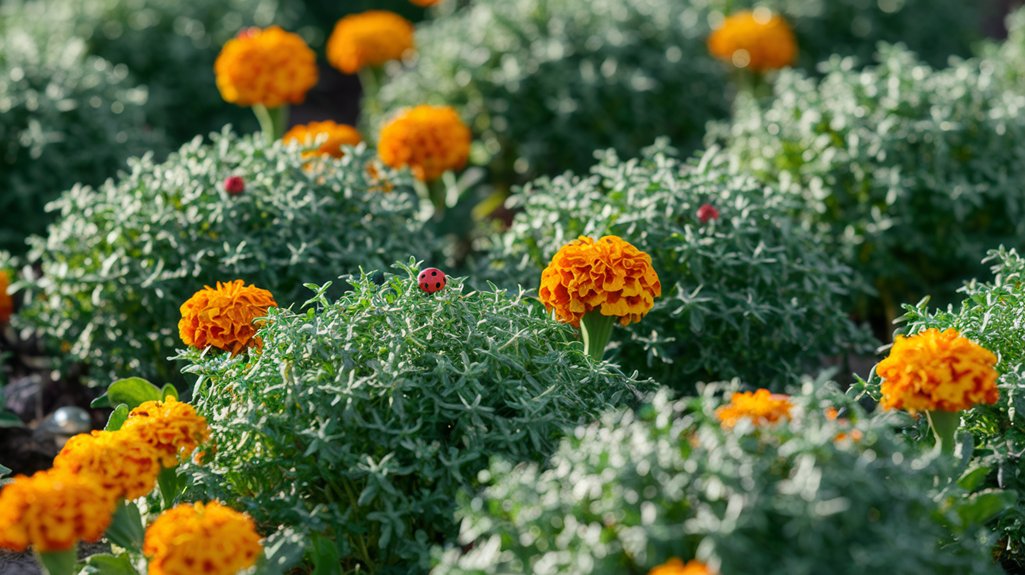
While exploring ways to enhance the resilience of my microgreens, I’ve found that companion planting can be a game-changer. By strategically pairing microgreens with certain herbs and vegetables, I can create a natural defense system against pests.
For instance, planting basil alongside my microgreens helps repel aphids and whiteflies, while marigolds can deter nematodes. Additionally, these companions can boost growth and improve flavor.
It’s essential to research which plants thrive together; for example, radish microgreens pair well with mustard greens.
I’ve noticed that this synergy not only protects my crops but also enhances the overall health of my garden.
Maintaining Optimal Growing Conditions to Prevent Infestations
To keep my microgreens healthy and pest-free, I focus on maintaining ideal temperature and humidity levels.
Research shows that specific ranges can significantly reduce the risk of infestations.
Ideal Temperature Range
Maintaining the ideal temperature range is crucial for growing healthy microgreens and preventing infestations. I’ve found that most microgreens thrive best between 65°F and 75°F (18°C to 24°C). Temperatures outside this range can stress plants, making them more susceptible to pests. Here’s a quick reference table for you:
| Temperature Range | Ideal for Growth | Risk of Infestation |
|---|---|---|
| 55°F – 64°F | Slower growth | Low |
| 65°F – 75°F | Optimal growth | Moderate |
| 76°F – 85°F | Fast growth | High |
| 86°F and above | Stunted growth | Very High |
| Below 55°F | Dormant | Low |
Humidity Control Techniques
Humidity plays a vital role in the health of microgreens, as high moisture levels can create an environment ripe for mold and pests. To maintain optimal humidity, I often use a hygrometer to monitor levels closely. Ideally, I aim for a range of 40-60%.
If humidity spikes, I increase airflow by using fans or opening vents, which helps reduce moisture without compromising temperature.
Additionally, I’ve found that watering techniques matter; I water in the morning to allow excess moisture to evaporate throughout the day. If I need to raise humidity, I mist lightly in the early morning.
Handpicking and Trapping: Simple Solutions for Small Gardens

While pests can pose a significant threat to your microgreens, handpicking and trapping them offers a straightforward solution for small gardens. I’ve found that dedicating a few minutes each day to inspect my plants allows me to catch pests early. Using simple traps, like sticky traps or water-filled bowls, can also help reduce their numbers effectively.
Here’s a quick reference table for the types of pests you may encounter and the best handpicking or trapping methods:
| Pest | Handpicking Method | Trapping Method |
|---|---|---|
| Aphids | Remove by hand | Yellow sticky traps |
| Slugs | Collect at night | Beer traps |
| Whiteflies | Gently shake leaves | Yellow sticky traps |
These methods keep my microgreens safe and thriving!
Encouraging Beneficial Insects to Protect Your Microgreens
To enhance the protection of my microgreens, I focus on attracting beneficial insects that can naturally manage pests.
I start by planting flowers like marigolds and nasturtiums nearby; these attract ladybugs and lacewings, which are excellent at controlling aphids.
I also avoid using pesticides, as they can harm these helpful allies. Instead, I create a diverse habitat by incorporating herbs like dill and cilantro, providing shelter and food for beneficial insects.
Regularly watering my plants and maintaining healthy soil encourages a balanced ecosystem, allowing beneficial insects to thrive.
Lastly, I keep my garden clean by removing debris that might harbor pests, ensuring my microgreens have the best chance of staying healthy and pest-free.
Frequently Asked Questions
Can I Use Chemical Pesticides on Microgreens?
I wouldn’t recommend using chemical pesticides on microgreens.
These delicate plants absorb substances quickly, which could pose health risks when consumed. I prefer safer alternatives like neem oil or insecticidal soap, as they’re effective against pests without harming the plants or my health.
Always check for organic options, too. Keeping my microgreens free from harmful chemicals ensures a healthier experience, both in growing and enjoying the vibrant flavors they offer.
How Often Should I Check for Pests in My Microgreens?
I check my microgreens for pests every few days, especially during their early growth stages.
It’s crucial to catch any issues early. I usually inspect the leaves and soil closely, looking for any signs of trouble.
If I notice anything unusual, I take action right away. Staying vigilant not only protects my plants but also ensures a healthy harvest.
Regular checks make a big difference in keeping my microgreens thriving!
What Are the Signs of Pest Damage on Microgreens?
I’ve noticed several signs of pest damage on my microgreens that can help you identify issues early.
Look for yellowing leaves, wilting plants, and visible holes in the foliage. You might also see webbing or tiny droppings around the base.
If you spot any unusual discoloration or stunted growth, it’s likely pests are at play. Regular inspection helps catch these signs before they escalate into more significant problems.
Are Certain Microgreens More Resistant to Pests?
I’ve found that some microgreens are indeed more resistant to pests than others.
For instance, arugula and radish microgreens tend to deter pests due to their strong flavors. Additionally, mustard greens and basil often exhibit natural resistance.
By choosing these varieties, I’ve noticed fewer pest issues in my garden.
It’s essential to combine resilient microgreens with good growing practices to enhance their natural defenses and keep unwanted pests at bay.
How Can I Prevent Pests in Indoor Microgreens?
To prevent pests in my indoor microgreens, I’ve found a few effective strategies.
First, I keep my growing area clean and free of debris. I also ensure proper air circulation to reduce humidity, which attracts pests.
Additionally, I use natural deterrents like neem oil or insecticidal soap when needed. Regularly inspecting my plants helps catch any issues early.
With these practices, I’ve successfully minimized pest problems in my indoor garden.
Conclusion
In conclusion, protecting your microgreens from pests doesn’t have to involve harsh chemicals. By understanding common pests, utilizing natural deterrents, and maintaining optimal growing conditions, you can foster a healthy garden. Handpicking pests and encouraging beneficial insects can further enhance your microgreens’ defenses. Embracing these safe, natural methods not only safeguards your plants but also promotes a thriving ecosystem. With a little effort and knowledge, you can enjoy bountiful, pest-free microgreens.

